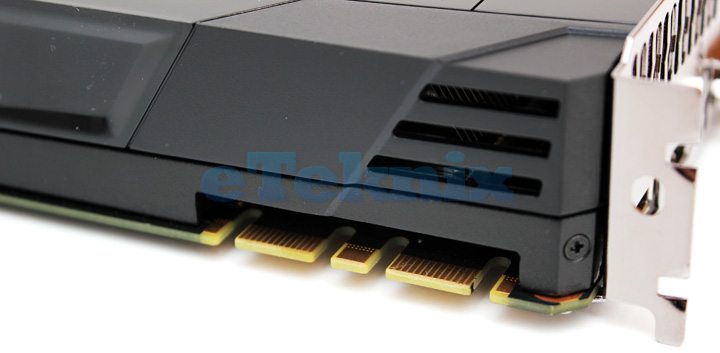Palit GEFORCE GTX 680 2GB Kepler Graphics Card Review
Andy Ruffell / 13 years ago
The card isn’t anything out of the ordinary, for a reference design. The only physical branding from Palit is a small logo of theirs. Other than this, we have a reference cooler which covers the whole card from every edge. A single fan is present towards the end of the card that assists in pushing cool air across the main part of the case and from what we’ve seen prior to today, the fan does offer a low noise output and good temperatures.

The fan is typical of what we’ve seen from both AMD and Nvidia. The fan is positioned towards the end of the card, which will act as a turbine to pull cool air in and pass it across the card and push any hot air out of the rear of the card by exhausting it out of the ventilated slats.

Due to this being a new card for the world, we wanted to explore every angle. The card, as you can see, takes up two expansion slots in your chassis, with the cooler at the same level. There is some GEFORCE GTX branding at the top of the card in bright green.

When I first saw this card, and the new GEFORCE GTX branding, I could only think of one thing; Batman Arkham Asylum/City. The font and colouring just reminds me of that game, which is funny as Nvidia have done a lot with that game, so maybe this card has had some influence from it?

Generally, we’d expect a 6-pin and an 8-pin PCI-Express power connector on a high-end card, but the GTX 680 does things slightly differently. Instead of this typical configuration, we find a two 6-pin PCI-Express power connectors, which leads us to expect some promising power consumption figures from our system with this card installed.

For those who have more money than sense, you may want to get some extreme performance by utilising multi-GPU technology. This card comes with two SLI connectors, allowing for FOUR GTX 680’s to sit in Quad SLI, and don’t worry, it will only set you about around £2000 in total

For us, this is a very interesting part of the card, purely because I use multiple screens on a day to day basis and until now has required two Nvidia cards or a GTX 590 to utilise multi-screen technology. Now that we have four display outputs, Nvidia have also increased functionality in terms of Nvidia Surround. You can now utilise 3 screens for gaming plus a fourth screen for chat, social networking, email or what we personally prefer; on-the-fly overclocking and monitoring. In terms of display connectors, we find a single-link DVI port, dual-link DVI port, HDMI port and full-size DisplayPort.
Surrounding these connectors, we also find a lot of ventilated slats to exhaust any hot air out of the rear of the card that the single fan pushes this way.

Looking at GPU-Z, we were happy to see this card supported straight out of the box in the newest version. In terms of speeds, we find the typical reference speeds of 1006MHz on the GPU core clock and 1502MHz on the memory clock (6Gbps Effective). As time goes on, we should see the likes of Palit, among other brands developing overclock editions, and while we could have spent most of this article overclocking things, we decided to leave that to another article, where we could touch on things a lot further.




















